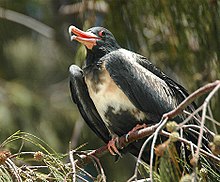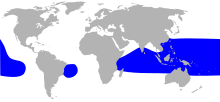Lesser frigatebird
| Lesser frigatebird | |
|---|---|
 |
|
| Scientific classification | |
| Kingdom: | Animalia |
| Phylum: | Chordata |
| Class: | Aves |
| Order: | Suliformes |
| Family: | Fregatidae |
| Genus: | Fregata |
| Species: | F. ariel |
| Binomial name | |
|
Fregata ariel (G.R.Gray, 1845) |
|
 |
|
| Range map | |
The lesser frigatebird (Fregata ariel) is a seabird of the frigatebird family Fregatidae. At around 75 cm (30 in) in length, it is the smallest species of frigatebird. It occurs over tropical and subtropical waters across the Indian and Pacific Oceans as well as off the Atlantic coast of Brazil.
The lesser frigatebird is a lightly built seabird with brownish-black plumage, long narrow wings and a deeply forked tail. The male has a striking red gular sac which it inflates to attract a mate. The female is slightly larger than the male and has a white breast and belly. Frigatebirds feed on fish taken in flight from the ocean's surface (often flying fish), and sometimes indulge in kleptoparasitism, harassing other birds to force them to regurgitate their food.
The lesser frigatebird was first described as Atagen ariel by the English zoologist George Gray in 1845 from a specimen collected on Raine Island, Queensland, Australia. The lesser frigatebird is one of five closely related species belonging to the genus Fregata. The other four are: the great frigatebird (Fregata minor), the Christmas frigatebird (Frigata andrewsi), the magnificent frigatebird (Fregata magnificens) and the Ascension frigatebird (Fregata aquila). The genus is the only member of the Fregatidae family.
Three subspecies are recognised:
Some ornithologists have questioned the validity of these subspecies as they appear to differ only in their size.
The lesser frigatebird is the smallest species of frigatebird and measures 66–81 cm (26–32 in) in length with a wingspan of 155–193 cm (61–76 in) and long forked tails. Male birds weight 625–875 g (1.378–1.929 lb). Female birds are heavier and weight 760–955 grams (1.676–2.105 lb). Like all frigatebirds the male has a large red sac on the front of the throat which is inflated during courtship. Courtship display also involves a variety of calls, bill rattling and spreading of the wings. The male is mostly all black save for a white patch on the flank which extends on to the underwing as a spur. Males also have a pale bar on the upper wing. Females have a black head and neck with a white collar and breast as well as a spur extending on to the underwing. The female also has a narrow red ring around the eye. Juveniles and immature birds are more difficult to differentiate but the presence of the spurs of white in the armpits is a helpful distinguishing sign.
...
Wikipedia

